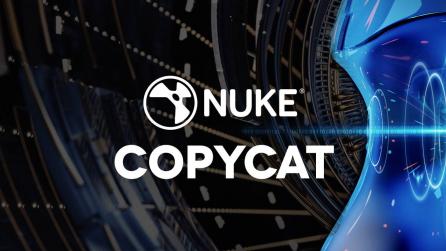Essential Nuke features to automate your animation process
Animation is the hot topic currently sweeping the Media and Entertainment industry. With its popularity growing, it seems that there’s no stopping the rising giant and the challenges that come with it.
But it doesn’t have to be a cause for alarm. Instead, we can turn to the somewhat unsung hero of production—automation.
The importance of automating parts of your pipeline can’t be understated, especially when it comes to animation production. It allows your studio to work more efficiently, and get the most out of your resources. Plus, it reduces artist overhead and enables them to put their creative energy into making their shots beautiful, instead of the mundane tasks artists face.
Compositing tool Nuke is key to efficiently adding automation into your animation pipeline. In this article, we walk through the ins and outs of automating your workflow using Nuke and the most important features to use when setting your studio up for animation productions.

Example of using LiveGroups in Nuke
Work on a shot at the same time as others
First up is LiveGroups, which has firmly established itself as an important part of animation pipelines. This powerful system is used for creating dynamically nested scripts, each of which can be worked on in parallel. LiveGroup workflows enable greater shot collaboration, giving multiple artists the ability to work on different parts of a shot simultaneously and utilizes a reliable versioning system to ensure everyone's work is up to date. It offers a robust workflow with heightened collaboration and gives artists complete creative control over their work.
But LiveGroups aren’t just limited to this functionality.
LiveGroups also make it possible for scripts to be reused in multiple places, so sharing work is easy. A specific look or effect can be wrapped in a LiveGroup and shared across a whole team. If any changes need to be made, this can be done in the master script, and anyone using that LiveGroup can easily pick up the new version.
This makes LiveGroups an ideal tool for templating and automation. Shot scripts can be set up using LiveGroups for each section, and these can then be updated and batch rendered, significantly cutting down the amount of attention required for individual shots. By incorporating LiveGroups into their workflows, some studios have been known to only have to manually composite half of their shots, as they can set up the rest to use LiveGroups, reusing effects and treatments which have already been approved. This is a massive time-saver when facing tight animation deadlines.
As with most of Nuke, LiveGroups have robust Python support, including a series of Python callbacks that enable LiveGroups to be integrated into your user and asset management systems. This helps to ensure that working with LiveGroups across your pipeline is efficient and seamless.
Automate repetitive tasks
Extending Nuke’s automation even further is its Python API, which allows repeatable tasks to be run programmatically. This allows for the more mundane and time-consuming tasks regularly faced in animation productions to be automated. Often, these tasks don’t require a lot of creative input from artists, so automating them means you can free up your artists to focus on what they are good at—making amazing images.
The Python API enables Nuke to be fully integrated into any animation pipeline. Whether you want to pass data between Nuke and other software packages, hook it up to your asset or shot management system, build custom tools for your artists, or batch process renders, Nuke's Python API allows you to customize the software to suit the specific needs of your studio.
It can also automate the more tedious tasks faced in animation projects, enabling pipeline teams to write Python scripts for batch processing tasks such as setting up templates or rendering Nuke Scripts. All this and more can be done without having to open Nuke’s UI.

Providing powerful tools for script template generation, Nuke’s Python API enables pipeline teams to unlock new ways for artist teams to stay organized and manage their shots. Pipeline TDs can write code for automatically ingesting 3D renders and splitting them out into the required AOVs. These can then be recombined in the artist’s desired manner. By using Python to auto-generate script templates, these processes can reduce artist overhead and help ensure consistency across shots.
Optimize your pipeline with Deep
Deep compositing is another key part of creating an efficient animation pipeline. Using Deep images, 3D renders can be combined in any order as Nuke will correctly layer all the elements, so artists don’t need to worry about which objects are where. Template scripts can arbitrarily combine multiple Deep images and artists can trust that Nuke will handle the occlusions—all this makes Deep a great way to build templates.

Example of Deep compositing in Nuke
Deep compositing also minimizes the amount of rendering artists need to do, by removing the need for elements to be rendered without predetermined holdouts. For example, if there are three characters in a scene and an animation change is needed on one of them, only that one character needs to be re-rendered, and using Deep, can be layered into the rest of the shot correctly. Deep enables studios to reduce rendering time and increase artist efficiency. Artists don’t have to wait around for renders—instead, they can work seamlessly on their shot whilst saving huge amounts of time and effort.
In combination with LiveGroups and Nuke's Python API, Deep can be a powerful tool used for automatic script generation, which can significantly cut down on the amount of time artists need to spend on individual shots.
It’s time to get automated
All in all, the key to efficiency is automation and this, in turn, ensures that you can expertly produce animation content with ease.
While there is a lot of work that isn’t creative on animation projects, using Nuke to automate your pipeline allows your artists to put their efforts into what counts, whether that be perfecting a shot or smashing deadlines. As we look to the future, the Nuke team is always looking to improve and ensure that you can automate as efficiently as possible.
For example, the Nuke family tools provide the ability to easily create slap comps on the timeline whilst using the compositing toolset. These comps give teams a rough idea of how the different layers merge together to create a shot. While it’s not the final shot, it allows animators to review a shot in context and check their renders match what’s going to be in the final image. It also means that VFX Supervisors can see how the shots line up and if everything is going to work together. Artists can automate these slap comps by pulling in the relevant assets associated with their specific shot and then generating the slap comps in Nuke Studio or Hiero.

Example of using CopyCat in Nuke
The recent Nuke 13.0 release saw the introduction of a new machine learning toolset and CopyCat, a node that allows artists to train neural networks to create effects that can then be applied to a specific shot, a sequence, or potentially an entire show. It aims to save artists time, removing the burden of repeatable tasks while also ensuring they have the creative freedom to perfect their shot.
It is features like these that further what artists, and studios, can do with automation and make their pipelines more efficient—and in the face of tightening deadlines and increasing demands, means you can tackle any animation project head-on with the reduced worry of industry pressures.
Learn more about how Nuke is used in animation
Read the first article in our series
Want to learn more about animation?


